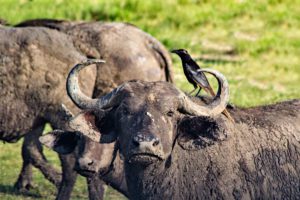Murchison Falls National Park, the largest in Uganda, is located on the banks of the River Nile, downstream from the falls it was named after. The reserve is said to have been favoured by Winston Churchill.
We stayed in the park for three nights at Paraa Safari Lodge and as well as visiting the falls, enjoyed three game drives, one in the morning and two in the afternoon. All began with a short drive on what was the relatively wide red-dust road which bisects the park, before turning off onto narrower tracks, passing the Pakuba airstrip.
Drive 1 – starting at 4pm our first sighting was almost immediate: five elephants roaming around the lodge’s staff quarters hoping for treats. Entering deeper into the park, we found the wide, open plains of the savannah grassland made animals easy to spot, with cloudy ominous skies providing a good background for photos. Antelopes abounded and ranged in size from the small, gazelle-like oribi to the large Jackson’s Hartebeest, with its dark coat and long thin face. This was also our first, but certainly not last, sight of the Ugandan kob, the national animal which features on the country’s coat of arms. We also spotted elephant, Rothschild’s giraffe with the males being identified through darker markings, warthog running with their tails in the air and herds of African buffalo. Birdlife was similarly prevalent and included: the Abyssinian ground hornbill (the male having a red face and the female blue), marabou stork, and guinea fowl. However, our favourite moment was watching, at a relatively close distance, a male and collared female lion, with the latter laid on her back and feet in the air.
Drive 2 – starting at 6.15am our first sighting was a giraffe on the main track, distracted by the lights of the three vehicles surrounding it. Whilst Ugandan kob, giraffe and elephant continued to dominate our drive, new animal sightings included a side-striped jackal, baboons in trees and the patas monkey, found in northern Uganda. Vultures circled the remains of a kill hunting for a final scrap of meat, and whilst not an avid twitcher, I became so fascinated by the variety of birds being pointed out, I began checking them off against a beginners birding list featuring 100 of the countries key birds. Two that were particularly striking due to their black and red feathers were the black headed gonolek and black winged red bishop, but there were also several species of owls, eagles and storks to identify. After a picnic breakfast at Delta Point on the shores of Lake Albert, we drove along searching for shoebill, said to be Africa’s most keenly sought bird, but were sadly unsuccessful.
Drive 3 – setting off a little earlier than the previous afternoon for our third and final drive, we took a different direction passing a building which was going to become a museum of some type, an education centre, ranger barracks, army post and the old airstrip. Then back on familiar territory, we began spotting familiar animals, but new birds – the black bellied bustard, cori bustard and woodland kingfisher. Again, we headed for Lake Albert and found a magnificent sight greeting us: at least 40 giraffe, African buffalo, hippos on the land and in the water and many, many birds. We were mesmerised by the sight of so many giraffe in one place, and at the water’s edge, watched how they spread their front legs wide to get their neck to the ground to drink. We were the only vehicle, and it felt a very special moment to finish our time in the park.












